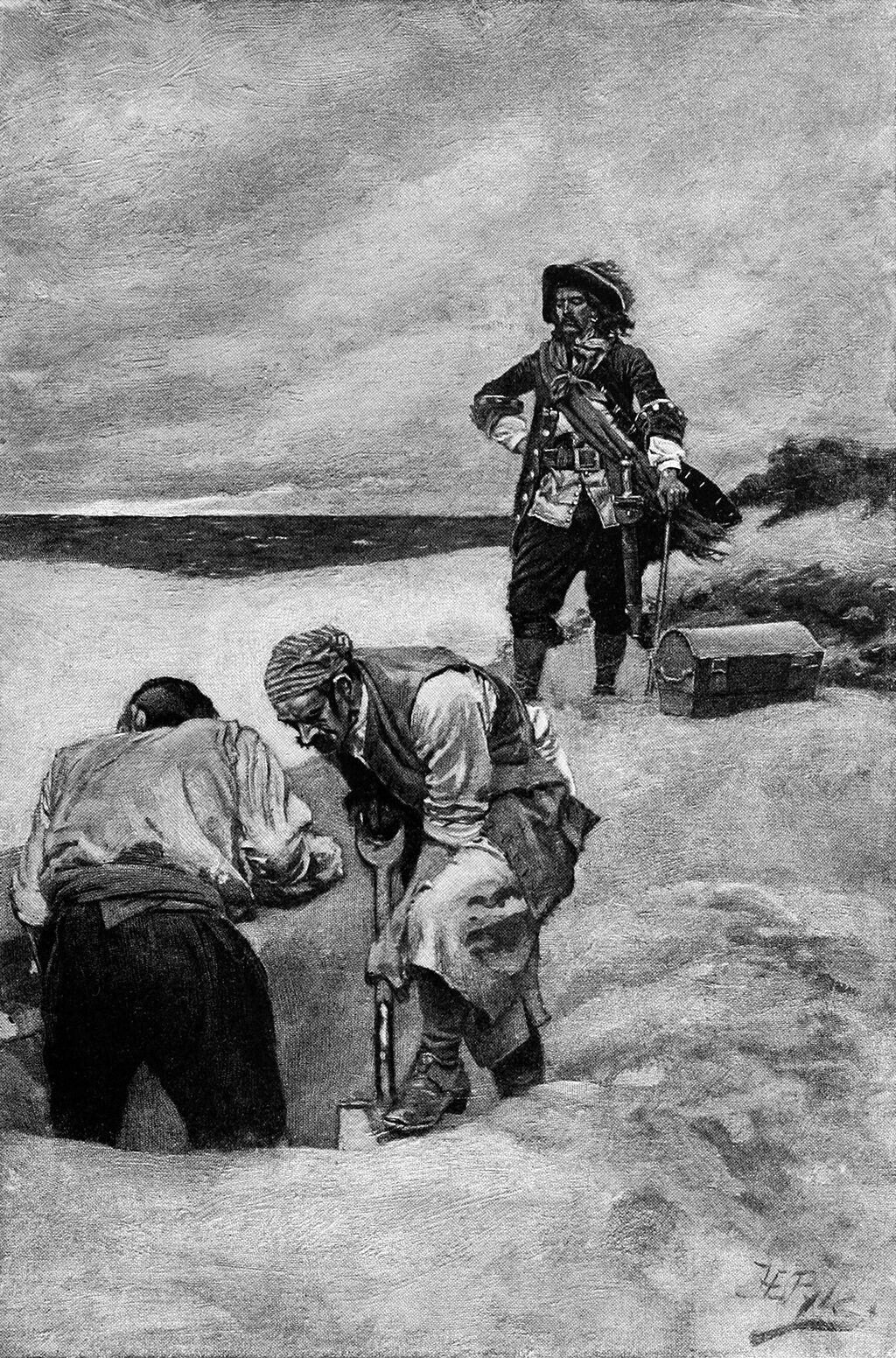In Search of Captain Kidd's Lost Treasure
Last week saw the anniversary of the execution of one of history’s most notorious pirates: Captain William Kidd.
Late in the afternoon of Friday 23 May, 1701, William Kidd stepped up to the gallows on the shore of the River Thames at Wapping, east of London. Visibly intoxicated, he delivered a rambling final speech attacking those who had borne witness against him, warning sailors to learn from his fate and to beware of politics. Unrepentant to the end, Kidd was twice hanged - on the first attempt the rope snapped. His body was then taken down river to Tilbury Point where it was tarred and hung in chains as a warning to other would-be pirates.

A romanticised depiction of Captain Kidd on Gardiner's Island from 'Howard Pyle's Book of Pirates' (New York, 1921). Image: Public Domain.
Colonial America, published by AM, contains numerous references to pirates and piracy, which are readily discoverable using the resource’s ground-breaking Handwritten Text Recognition (HTR) technology. Searching this vast resource reveals a fascinating document that illuminates the final months of Kidd’s life as he sought to escape imprisonment and ultimately the hangman’s noose. What is more, it provides tantalising clues to as to the nature and location of his famous lost treasure.
In July 1699 Kidd found himself locked up in Boston Gaol, the prisoner of Richard Coote, Earl of Bellomont and Governor of Massachusetts. Bellomont, who had been a member of the syndicate that had originally commissioned Kidd in 1695 to conduct privateering raids during the war with France, had encouraged Kidd to come to Boston with the promise of a full pardon for his exploits, which had now been deemed by the English government to be the work not of an authorised privateer but that of an ‘obnoxious pirate’. It was however a trick and within days of setting foot ashore Kidd was arrested.
Although Kidd was keen to secure exoneration for his actions, which had crossed the line from privateering into piracy, he was no fool. Foreseeing the possibility that he was walking into a trap, he had taken the precaution to hide his treasure, which could if necessary be used as a bargaining chip to help negotiate his pardon and release. One of the locations where Kidd buried his loot was on Gardiner’s Island, just off the eastern tip of Long Island. However shortly after Kidd’s capture this cache was recovered by the authorities as on 25 July 1699 Bellomont drew up an inventory of what had been concealed on the island. In one chest they found over 200 bars of silver, an enamelled silver box inlaid with diamonds and a diamond ring. In another casket they discovered no less than 67 rubies.
Yet the hoard unearthed from Gardiner’s Island may have only been a tiny fraction of Kidd’s fortune. In a letter to the Board of Trade, dated 5 January 1699/1700, Bellomont reported that a fortnight previously Kidd had sent word to him via the jailer with a proposition. Kidd proposed that if Bellomont were to let him go to the place where he had left his ship the Quedagh Merchant and to sail to ‘St Thomas’s Island and Curaçao’ in the Caribbean he would bring back a treasure worth some fifty or sixty thousand pounds, ‘which would otherwise be lost’. To allay any fears that he would use the opportunity to escape, Kidd said that he would be willing to go as Bellomont’s prisoner. However, Bellomont, eager to completely disassociate himself from Kidd, was certainly not going to let him take to the high seas again. In reply Bellomont told Kidd that ‘he was the King’s prisoner’ and therefore ‘could hearken to no such proposition’.
Even so, the promise of further undiscovered riches was a tempting prospect and Bellomont instructed the jailer to try to gain Kidd’s confidence and to get him to reveal the location of the treasure. However, the jailer proved wholly unsuccessful in this task and Kidd only said that ‘nobody could find it but himself and would not tell any further’.

Part of the Earl of Bellomont's letter discussing Captain Kidd's treasure (TNA, CO 5/1043). Image © The National Archives, London, UK. Further reproduction prohibited without permission.
Part of the Earl of Bellomont's letter discussing Captain Kidd's treasure (TNA, CO 5/1043). Image © The National Archives, London, UK. Further reproduction prohibited without permission.
Whether the claims of a second hoard were true or merely an elaborate ruse in order to attempt an escape is unknown. Kidd took the secret with him to the gallows. Fortune-hunters have been searching for his lost treasure ever since.
For more information on Colonial America, including demo access and price enquiries, please email us at info@amdigital.co.uk.
Recent posts

The blog highlights American Committee on Africa, module II's rich documentation of anti-apartheid activism, focusing on the National Peace Accord, global solidarity, and student-led divestment campaigns. It explores the pivotal role of universities, protests, and public education in pressuring institutions to divest from apartheid, shaping global attitudes toward social justice and reform.

This blog examines how primary sources can be used to trace the impact of young voices on society, particularly during pivotal voting reforms in the UK and the US. Explore materials that reveal insights into youth activism, intergenerational gaps, and societal perceptions, highlighting their interdisciplinary value for studying youth culture, activism, and girlhood across history.
